

DISNEYLAND
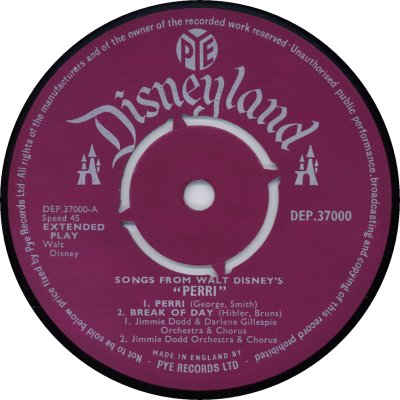
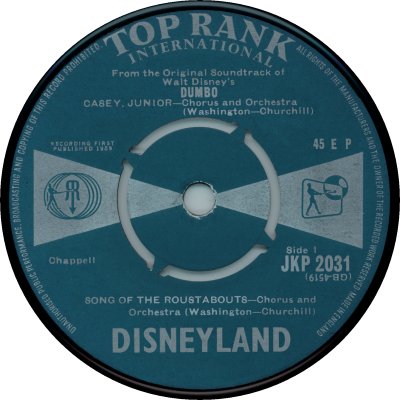
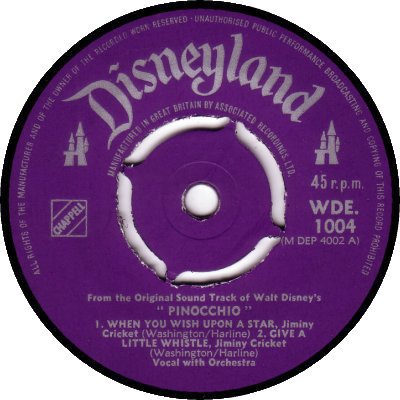
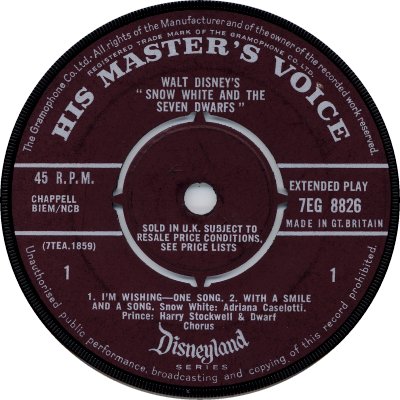
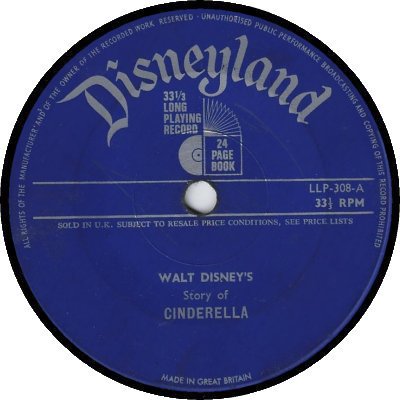
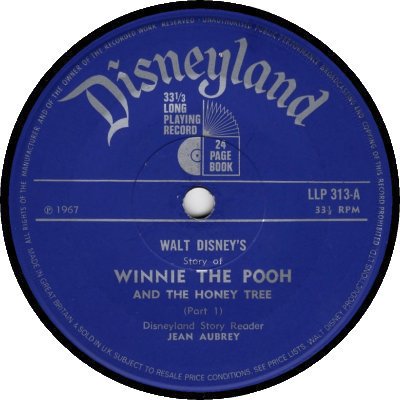
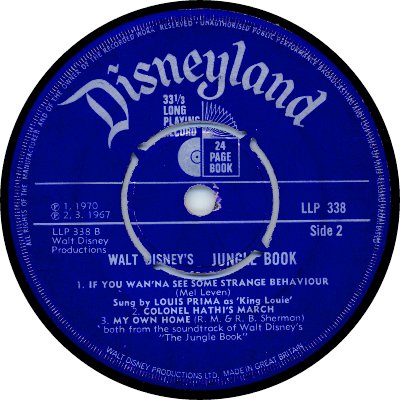
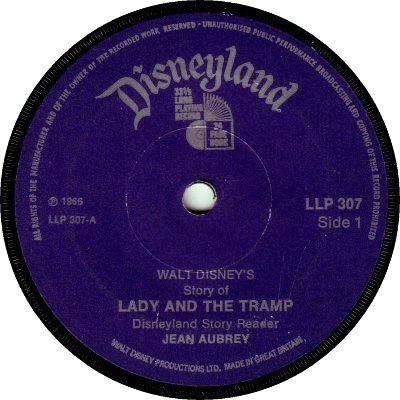
One of the Disney company's
family of labels, others being Buena Vista, Disneyland Doubles and Disneyland
Super Six (q.v. all). Disneyland seems to have made its first,
brief, appearance on 7" records in Britain in or around 1958, through
Pye (1), though the date of that record has yet to be firmly established. The following year
Gala issued a short series of Disney EPs with their own
special label, but the Disneyland name only appeared
on the cover - the label had Walt Disney's name on it. Numbering
was in a dedicated GWD-700 series. There was also at least one Disney
EP on the ordinary Gala label but with a special prefix: it featured the
story and two songs from 'Sleeping Beauty' (45XPWW-1; 1959). In that same year Top Rank put
out its own short series of Disneyland EPs as well as at least one
single, 'First Name Initial' by Annette (JAR-233; 11/59); the EPs had the Disneyland name
added to the standard Top Rank label in a very plain font (2). Allied
Records joined in in 1961, issuing half a dozen more Disney EPs: these
came out on the actual Disneyland label, which in this case came in a purplish colour (3)
or in blue. Numbers were in the WDE-1000s. A couple
of Disney singles by Hayley Mills came out on Decca in 1961-62, but
without any special logo. The Disneyland name seems to have next been seen
when it featured as a small additional logo on a series of His Master's
Voice EPs of songs from Disney films (4), a series which continued sporadically
from 1963 until 1966. According to 'Billboard' of the 5th of November
1966, EMI's contract to issue Disney material on HMV was due to expire in
December of that year, and it seems to have done so, but EMI continued to
distribute the various Disney labels until the spring of 1969.
The next
set of 7" records to appear on the Disneyland label in Britain were
blue-labelled 33 1/3 rpm EPs which often featured someone telling a story from a Disney film on
one side and two songs from the film on the other; they were
known as 'Little LPs'. The EPs came with a twenty-four page booklet, as the label indicates. The series
first appeared in 1966 in the States - there was an advert for
the first dozen issues in 'Billboard' magazine of the 17th September
of that year, and it claimed that by that point the 'Little LPs' were 'The biggest
selling children's line of records in the world', so presumably they must have been
on the market for a while by then. 'Billboard' of the 5th
of November 1966 said that the first half-dozen British 'Little LPs'
had been released 'last month', which gives us a starting date - by agreement
with EMI they were issued before the Disney / EMI /HMV contract expired. Numbering was in the
LLP-300s, and the series reached at least LLP-457, 'The Dark Crystal',
which came out in 1985. Many of the EPs
were re-recorded in French for release in France; the French versions were
given the same catalogue numbers as the American ones but with an 'F' suffix.
Other countries such as Italy had their own adapted
versions.
Trying to put
together a
'Little LP' discography proved complicated. To begin with, the dates on the records
frequently refer to when the material was first made available rather than to when
it was issued in LLP form. A lot of the American records were not
released in this country, and the British issues didn't keep in step with their American counterparts
although they kept the original American catalogue numbers. The storyteller
was often changed to suit the British audience; a handful of examples can
be found where the original UK release with the American narrator has been reissued
with a replacement narrator, presumably one whose delivery was thought to be more in tune
to British ears. This explains why several records can be found with
different credits and dates on them - for example LLP-308, 'Cinderella', comes in
a 1967 version by Robie Lester and a 1970 one
by Katie Boyle. Often the dates on the sleeve don't correspond to those on the labels,
thanks to redesigns and re-pressings - many of the records were re-pressed several times and
were handled by different companies, which merely adds to the confusion. Happily, ploughing through
old issues of 'Record Retailer' and 'Billboard' has enabled
me to put together a listing in which I have moderate confidence: it's lower down
the page.
The first batch of six UK Little LPs, from October
1966, consisted of numbers 302, 304, 306, 307, 308 and 310, as referenced
on their sleeves. The storytellers were anonymous on the
labels, though on the sleeves and on re-pressings they are
usually named. The labels, which had two lines across them, had a reference
to 'resale price conditions' across their centres and 'Made in Great Britain' at
the bottom (4). In 1967 numbers 303, 311 to 313, and 319 were added. At
this time the labels still had lines, but the reference to 'resale price
conditions' was now at the bottom on the perimeter, alongside a reference to Walt
Disney Productions Ltd (5). Numbers 301 and 317 were added to
the list in 1968. The 'retail price conditions' wording became obsolete in the
summer of 1969, and it disappeared from the labels of records which were pressed after that
point (6). The first LLPs without the wording were new additions
321, 322, 330, 332, 333 and 334, all of which came out in October
1969. Finally the lines across the labels disappeared, with
issues from October 1971 onwards (7). Needless to say, popular records were
re-pressed several times and can be found with several different types of
label.
As far as distribution of the 'Little LPs' is concerned,
'Record Retailer' of the 12th of March 1969 says that EMI had been doing the
job since 1966 but that Pye would be taking over from the end of that month.
Disneyland stayed with Pye for a couple of years before signing
a three-year pressing and distribution deal with CBS in April
1971 ('RR', 10th April). When that agreement expired, at the
end of April 1974, Disneyland returned to Pye in another three-year deal ('Music Week', 20th April).
Looking back, 'MW' of the 13th of August 1977 referred to the deal as
a licensing one, and revealed that when it came to an end Disneyland had moved again,
this time to budget company Pickwick. According to 'MW' of the 26th of January
1980 the Pickwick agreement hadn't covered the 'Little LP' series, which had
been available only via EMI imports, presumably since the end of the second
Pye deal - at that point a new distributor was being sought
for them, as EMI Imports had closed.
Pressing was done independently until 1971,
frequently by British Homophone - look out for the deep, chunky cut of the matrix
number, at 6 o'clock in the run-off. If the 1971 agreement
with CBS was indeed for pressing as well as distribution it seems reasonable to
assume that firm manufactured the 'Little LPs' from then until 1974.
Again, Pye's licensing deal in 1974 presumably covered manufacture as well as
distribution. Both CBS and Pye appear to have re-pressed popular items
when stocks got low - the fifth example shown above, with its
late-style label and early catalogue number, is a Pye pressing. Thanks to three members of
45cat for the use of their scans on this page:
Malcolm Henderson (3), Ade Macrow (5) and Harbottle (6). See also 'Disney
custom pressings'.
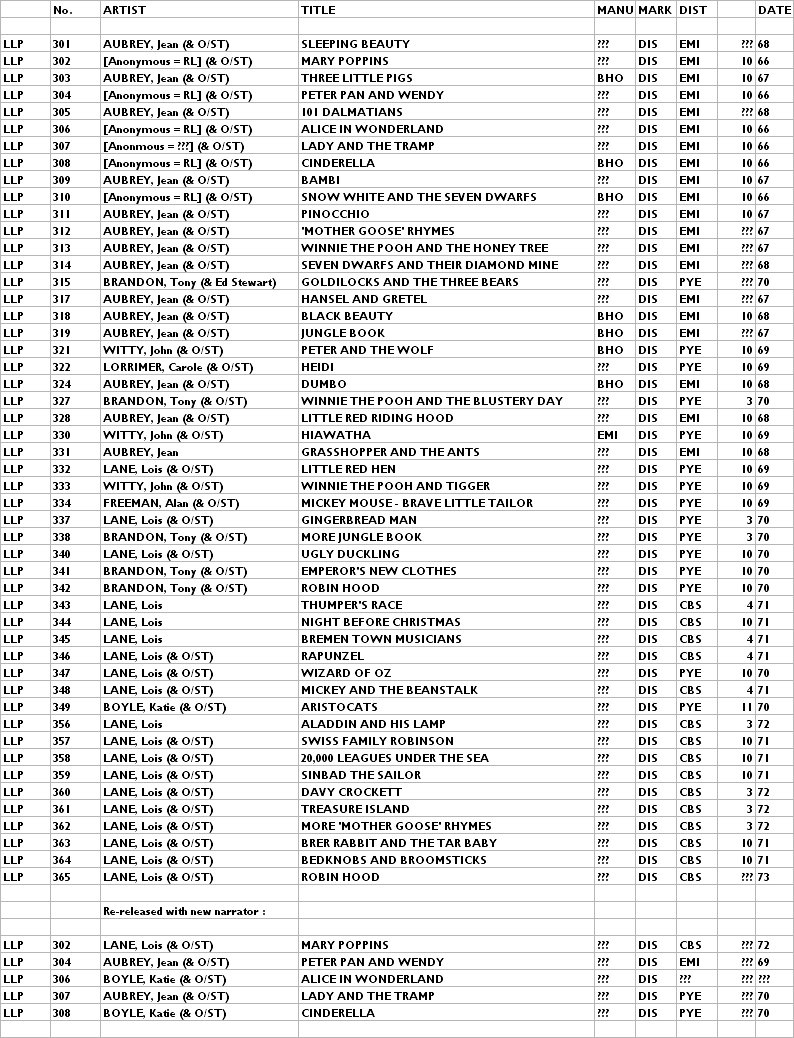


Copyright 2006 Robert
Lyons.












